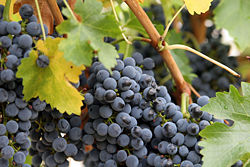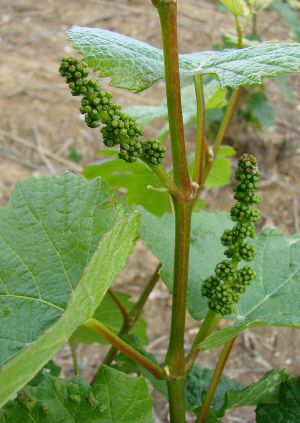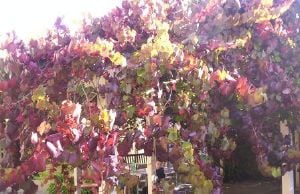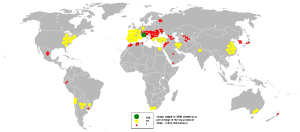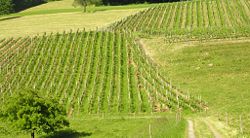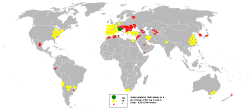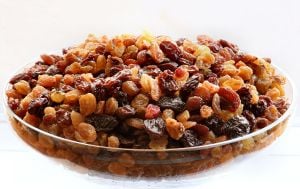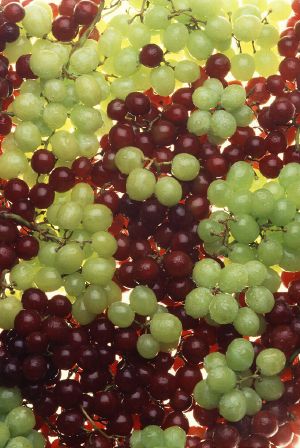Difference between revisions of "Grape" - New World Encyclopedia
Katya Swarts (talk | contribs) |
Rick Swarts (talk | contribs) |
||
| Line 1: | Line 1: | ||
{{Claimed}}{{Contracted}} | {{Claimed}}{{Contracted}} | ||
| − | {{Taxobox | + | [[Image:Close up grapes.jpg|thumb|right|250px|[[Red wine]] grapes]] |
| + | '''Grape''' is the common name for any of the vining [[plant]]s belonging to the about 60 species comprising the genus '''''Vitis''''' in the [[flowering plant]] family [[Vitaceae]]. It is also the name for the non-[[Climacteric#In_Botany|climacteric]] [[fruit]] that grows on | ||
| + | |||
| + | the [[Perennial plant|perennial]] and [[deciduous]] woody [[vine]]s of the [[genus]] ''[[Vitis]]''. Grapes can be eaten raw or used for making [[jam]], [[grape juice]], [[Jelly (fruit preserves)|jelly]], [[wine]] and [[grape seed oil]]. | ||
| + | |||
| + | ==''Vitus''== | ||
| + | {{Taxobox | ||
| color = lightgreen | | color = lightgreen | ||
| − | | name = | + | | name = ''Vitis'' |
| − | | image = | + | | image = Vitis californica with grapes.jpg |
| − | | image_width = | + | | image_width = 240px |
| − | | image_caption = | + | | image_caption = ''Vitis californica'' with fruit |
| regnum = [[Plant]]ae | | regnum = [[Plant]]ae | ||
| divisio = [[Flowering plant|Magnoliophyta]] | | divisio = [[Flowering plant|Magnoliophyta]] | ||
| Line 13: | Line 19: | ||
| familia = [[Vitaceae]] | | familia = [[Vitaceae]] | ||
| genus = '''''Vitis''''' | | genus = '''''Vitis''''' | ||
| − | | | + | | subdivision_ranks = [[Species]] |
| − | |||
| subdivision = | | subdivision = | ||
| + | *''[[Vitis vinifera]]'' | ||
| + | *''[[Vitis acerifolia]]'' | ||
| + | *''[[Vitis aestivalis]]'' | ||
| + | *''[[Vitis amurensis]]'' | ||
| + | *''[[Vitis arizonica]]'' | ||
| + | *''[[Vitis × bourquina]]'' | ||
| + | *''[[Vitis californica]]'' | ||
| + | *''[[Vitis × champinii]]'' | ||
| + | *''[[Vitis cinerea]]'' | ||
| + | *''[[Vitis coignetiae]]'' | ||
| + | *''[[Vitis × doaniana]]'' | ||
| + | *''[[Vitis girdiana]]'' | ||
| + | *''[[Vitis labrusca]]'' | ||
| + | *''[[Vitis × labruscana]]'' | ||
| + | *''[[Vitis lincecumii]] | ||
| + | *''[[Vitis monticola]]'' | ||
| + | *''[[Vitis mustangensis]]'' | ||
| + | *''[[Vitis × novae-angliae]]'' | ||
| + | *''[[Vitis palmata]]'' | ||
| + | *''[[Vitis riparia]]'' | ||
| + | *''[[Vitis rotundifolia]]'' | ||
| + | *''[[Vitis rupestris]]'' | ||
| + | *''[[Vitis shuttleworthii]]'' | ||
| + | *''[[Vitis tiliifolia]]'' | ||
| + | *''[[Vitis vulpina]]'' | ||
}} | }} | ||
| − | |||
| − | |||
| − | + | '''''Vitis''''' is a genus of about 60 species of vining plants in the [[flowering plant]] family [[Vitaceae]]. The genus is made up of species predominantly from the Northern hemisphere. It is economically important as the source of [[grape]]s, both for direct consumption of the fruit and for fermentation to produce [[wine]]. The study and cultivation of grapevines is called [[viticulture]]. | |
| + | |||
| + | Vitaceae are a family of dicotyledonous flowering plants including the grape and Virginia creeper. The family name is derived from the genus Vitis. The name sometimes appears as Vitidaceae, but Vitaceae is a conserved name and therefore has priority over both Vitidaceae and another name sometimes found in the older literature, Ampelidaceae. | ||
| + | |||
| − | |||
| − | + | ===Biology=== | |
| − | + | [[Image:Vigne inflorescence 2.jpg|left|thumb|Flower buds of ''Vitis vinifera'']] | |
| − | + | ''Vitis'' is distinguished from other genera of Vitaceae by having petals which remain joined at the tip and detach from the base to fall together as a calyptra or 'cap'. The [[flower]]s are unisexual or modified to act functionally as unisexual, they are pentamerous with a hypogynous disk. Calyx is greatly reduce or nonexistent in most species and the petals are joined at the summit into one unit but separated at the base. Flower buds are formed later in the growing season and overwinter for blooming in spring of the next year. There are two types of flowers produced, sterile flowers with five long filaments and erect stamens with undeveloped pistils and fertile flowers with well developed pistals and that have five undeveloped reflexed stamens. The [[fruit]] is a [[berry]], normally produced with four or less per flower by way of aborted embryos, ovid in shape and juicy.<ref>Gleason and Cronquist volume 2, ''New Britton and Brown Illustrated Flora of the Northeastern United States and Adjacent Canada''. ISBN 63-16478 Page 517</ref> | |
| − | + | ||
| − | + | In the wild, all species of ''Vitis'' are normally [[plant sexuality|dioecious]], but under domestication, variants with [[perfect flower]]s appear to have been selected. | |
| − | + | ||
| − | + | Most ''Vitis'' species have 38 chromosomes (n=19), but 40 (n=20) in subgenus ''[[Muscadinia]]''. In that respect the ''Muscadinia'' are the same as other ''Vitaceae'' such as ''[[Ampelocissus]]'', ''[[Parthenocissus]]'', and ''[[Ampelopsis]]''. | |
| − | + | ||
| + | ===Uses=== | ||
| + | The fruit of several ''Vitis'' species are grown commercially for consumption as fresh [[grape]]s and for fermentation into [[wine]]. ''[[Vitis vinifera]]'' is much the most important species. | ||
The leaves of the grape vine itself are considered edible and are used in the production of [[dolmades]]. | The leaves of the grape vine itself are considered edible and are used in the production of [[dolmades]]. | ||
| + | |||
| + | === Species === | ||
| + | [[Image:Ornamental grape.jpg|thumb|left|''Vitis coignetiae'' with autumn leaves]] | ||
| + | Most ''Vitis'' species are found in the temperate regions of the Northern Hemisphere in [[North America]] and [[Asia]] with a few in the tropics. The wine grape ''Vitis vinifera'' originated in southern [[Europe]] and southwestern Asia. The species occur in widely different geographical areas and show a great diversity of form. However they are sufficiently closely related to allow easy interbreeding and the resultant interspecific hybrids are invariably fertile and vigorous. Thus the concept of a species is less well defined and more likely represents the identification of different ecotypes of ''Vitis'' that have evolved in distinct geographical and environmental circumstances. | ||
| + | |||
| + | The exact number of species is not certain, with species in [[Asia]] in particular being poorly defined. Estimates range from 40 to more than 60.<ref>{{cite book |last=Galet |first=Pierre |title=Dictionnaire encyclopédique des cépages |year=2000 |publisher=Hachette Pratique |isbn=2012363318 }}</ref> Some of the more notable include : | ||
| + | |||
| + | *''[[Vitis vinifera]]'', the European grapevine. Native to the Mediterranean and Central Asia. | ||
| + | *''[[Vitis labrusca]]'', the Fox grapevine, sometimes used for wine. Native to the [[Eastern United States]] and [[Canada]]. | ||
| + | *''[[Vitis riparia]]'', the Riverbank Grapevine, sometimes used for winemaking and for jam. Native to the entire [[Eastern U.S.]] and north to [[Quebec]]. | ||
| + | *''[[Vitis rotundifolia]]'' (syn. ''Muscadinia rotundifolia''), the [[Muscadine]], used for jams and wine. Native to the [[Southeastern United States]] from [[Delaware]] to the [[Gulf of Mexico]]. | ||
| + | *''[[Vitis vulpina]]'' Frost grape. Native to the [[Midwest]] east to the coast up through [[New York]]. | ||
| + | *''[[Vitis coignetiae]]'' Crimson Glory Vine, a species from East Asia grown as an [[ornamental plant]] for its crimson autumn foliage. | ||
| + | |||
| + | There are many [[List of grape varieties|cultivars]] of grapevines; most are cultivars of ''V. vinifera''. | ||
| + | |||
| + | [[Hybrid]] grapes also exist, and these are primarily crosses between ''V. vinifera'' and one or more of ''V. labrusca'', ''V. riparia'' or ''V. aestivalis''. Hybrids tend to be less susceptible to frost and disease (notably [[phylloxera]]), but wine from some hybrids may have a little of the characteristic "foxy" taste of ''V. labrusca''. | ||
| + | |||
| + | ===Commercial Distribution === | ||
| + | [[Image:2005grape.PNG|thumb|left|Grape output in 2005]] | ||
| + | According to the "Food and Agriculture Organization" (FAO), 75,866 square kilometres of the world is dedicated to grapes. Approximately 71% of world grape production is used for wine, 27% as fresh fruit, and 2% as dried fruit. A portion of grape production goes to producing grape juice to be used as a sweetener for fruits canned "with no added sugar" and "100% natural". The area dedicated to vineyards is increasing by about 2% per year.<br style="clear:both"/>The following list of top wine-producers shows the corresponding areas dedicated to grapes for wine making: | ||
| + | *Spain 11,750 km² | ||
| + | *France 8,640 km² | ||
| + | *Italy 8,270 km² | ||
| + | *Turkey 8,120 km² | ||
| + | *United States 4,150 km² | ||
| + | *Iran 2,860 km² | ||
| + | *Romania 2,480 km² | ||
| + | *Portugal 2,160 km² | ||
| + | *Argentina 2,080 km² | ||
| + | *Australia 1,642 km² | ||
| + | |||
| + | Sources: FAO, [http://news.reseau-concept.net/images/oiv_uk/Client/Stat_2002_def2_EN.pdf Organisation Internationale de la Vigne et du Vin (pdf)], [https://www.awbc.com.au/winefacts/data/free.asp?subcatid=102 Australian Wine and Brandy Corporation]. | ||
| + | |||
| + | [[Image:Palatina.jpg|thumb|right|180px| [[Palatina]], a German grape]]{{Main|List of grape diseases|phylloxera}} | ||
| + | [[Phylloxera]] is an American root aphid that devastated ''V. vinifera'' vineyards in Europe when accitentally introduced in the late 19th century. Attempts were made to breed in resistance from American species, but winemakers didn't like the 'foxy' flavours of the hybrid vines. Fortunately, ''V. vinifera'' grafts readily onto rootstocks of the American species, and most commercial production of grapes now relies on such grafts. | ||
| + | |||
| + | The [[Black vine weevil]] is another root pest. | ||
Grapevines are used as food plants by the [[larva]]e of some [[Lepidoptera]] species - see [[list of Lepidoptera which feed on grapevines]]''. | Grapevines are used as food plants by the [[larva]]e of some [[Lepidoptera]] species - see [[list of Lepidoptera which feed on grapevines]]''. | ||
| − | + | ==Description== | |
| + | Grapes grow in clusters of 6 to 300, and can be black, blue, golden, green, purple, red, pink, brown, peach or white. White grapes are evolutionarily derived from the red grape. Mutations in two regulatory genes turn off production of [[anthocyanin]], which is responsible for the color of the red grape.<ref>{{cite journal|title=White grapes arose through the mutation of two similar and adjacent regulatory genes|author=Walker AR, Lee E, Bogs J, McDavid DA, Thomas MR, Robinson SP|journal=Plant J|year=2007|volume=49|issue=5|pages=772–85|pmid=17316172}}</ref>. | ||
== Grapevines == | == Grapevines == | ||
| − | [[Image: | + | {{main|Vitis}} |
| − | + | [[Image:Palatina.jpg|thumb|right|[[Palatina]], a German grape]] | |
| − | + | Most grapes come from [[List of grape varieties|cultivars]] of ''[[Vitis vinifera]]'', the European grapevine native to the Mediterranean and Central Asia. Minor amounts of fruit and wine come from American and Asian species such as : | |
| − | *''[[Vitis labrusca]]'', the North American table and grape juice grapevines, sometimes used for wine. Native to the [[Eastern | + | |
| + | *''[[Vitis labrusca]]'', the North American table and grape juice grapevines, sometimes used for wine. Native to the [[Eastern United States]] and [[Canada]]. | ||
*''[[Vitis riparia]]'', a wild vine of [[North America]], sometimes used for winemaking and for jam. Native to the entire [[Eastern U.S.]] and north to [[Quebec]]. | *''[[Vitis riparia]]'', a wild vine of [[North America]], sometimes used for winemaking and for jam. Native to the entire [[Eastern U.S.]] and north to [[Quebec]]. | ||
| − | *''[[Vitis rotundifolia]]'', the [[muscadine]]s, used for jams and wine. Native to the [[Southeastern | + | *''[[Vitis rotundifolia]]'', the [[muscadine]]s, used for jams and wine. Native to the [[Southeastern United States]] from [[Delaware]] to the [[Gulf of Mexico]]. |
*''[[Vitis vulpina]]'' Frost grape. Native to the [[Midwest]] east to the coast up through [[New York]]. | *''[[Vitis vulpina]]'' Frost grape. Native to the [[Midwest]] east to the coast up through [[New York]]. | ||
| − | * ''[[Vitis | + | *''[[Vitis amurensis]]'' Most important Asian species. |
| − | |||
| − | + | The [[sea grape]] ''[[Coccoloba uvifera]]'' is actually a member of the Buckwheat family ''[[Polygonaceae]]'' and is native to the islands of the [[Caribbean Sea]]. | |
| − | == | + | == Distribution and production == |
| − | |||
| − | |||
| − | |||
| − | |||
| − | |||
| − | |||
| − | |||
| − | |||
| − | |||
| − | |||
| − | |||
| − | |||
| − | |||
| − | |||
| − | |||
| − | |||
| − | |||
| − | |||
| − | |||
| − | |||
| − | |||
| − | |||
| − | |||
| − | |||
| − | |||
| − | |||
| − | |||
| − | |||
| − | |||
| − | |||
| − | |||
| − | |||
| − | |||
| − | |||
| − | |||
[[Image:GrapeField.jpg|thumb|250px|Grapevines]] | [[Image:GrapeField.jpg|thumb|250px|Grapevines]] | ||
| − | [[Image:2005grape.PNG|thumb|right|Grape | + | [[Image:2005grape.PNG|thumb|right|250px|Grape production in 2005]] |
| − | According to the "Food and Agriculture Organization" (FAO), 75,866 square kilometres of the world | + | According to the "Food and Agriculture Organization" (FAO), 75,866 square kilometres of the world are dedicated to grapes. Approximately 71% of world grape production is used for wine, 27% as fresh fruit, and 2% as dried fruit. A portion of grape production goes to producing grape juice to be used as a sweetener for fruits canned "with no added sugar" and "100% natural". The area dedicated to vineyards is increasing by about 2% per year. <!-- references needed: Popularity for the purple grape has increased tremendously over the past decade. In March 2006, the purple grape reached its peak in popularity by being preferred 83% of the time over green grapes in a University of Michigan poll. —> |
The following list of top wine-producers shows the corresponding areas dedicated to grapes for wine making: | The following list of top wine-producers shows the corresponding areas dedicated to grapes for wine making: | ||
| Line 107: | Line 143: | ||
Sources: FAO, [http://news.reseau-concept.net/images/oiv_uk/Client/Stat_2002_def2_EN.pdf Organisation Internationale de la Vigne et du Vin (pdf)], [https://www.awbc.com.au/winefacts/data/free.asp?subcatid=102 Australian Wine and Brandy Corporation]. | Sources: FAO, [http://news.reseau-concept.net/images/oiv_uk/Client/Stat_2002_def2_EN.pdf Organisation Internationale de la Vigne et du Vin (pdf)], [https://www.awbc.com.au/winefacts/data/free.asp?subcatid=102 Australian Wine and Brandy Corporation]. | ||
| − | + | == Seedless grapes == | |
| + | Seedlessness is a highly desirable subjective quality in table grape selection, and seedless cultivars now make up the overwhelming majority of table grape plantings. Because grapevines are [[Vegetative reproduction|vegetatively propagated]] by cuttings, the lack of seeds does not present a problem for reproduction. It is, however, an issue for breeders, who must either use a seeded variety as the female parent or rescue embryos early in development using [[Plant tissue culture|tissue culture]] techniques. | ||
| − | + | There are several sources of the seedlessness trait, and essentially all commercial cultivators get it from one of three sources: Thompson Seedless, Russian Seedless, and Black Monukka. All are cultivars of ''[[Vitis vinifera]]''. | |
| − | + | Contrary to the improved eating quality of seedlessness is the loss of potential health benefits provided by the enriched [[phytochemical]] content of grape seeds<ref>{{cite paper | |
| − | + | | author = Shi J, Yu J, Pohorly JE, Kakuda Y. | |
| − | + | | title = Polyphenolics in grape seeds-biochemistry and functionality. | |
| + | | date = 2003 Winter | ||
| + | | publisher = J Med Food. 2003 Winter;6(4):291-9. | ||
| + | | url = http://www.ncbi.nlm.nih.gov/sites/entrez?Db=pubmed&Cmd=ShowDetailView&TermToSearch=14977436&ordinalpos=1&itool=EntrezSystem2.PEntrez.Pubmed.Pubmed_ResultsPanel.Pubmed_RVDocSum | ||
| + | | accessdate = 2007-08-16 | ||
| + | }}</ref><ref>{{cite paper | ||
| + | | author = Parry J, Su L, Moore J, Cheng Z, Luther M, Rao JN, Wang JY, Yu LL. | ||
| + | | title = Chemical compositions, antioxidant capacities, and antiproliferative activities of selected fruit seed flours. | ||
| + | | date = 2006-05-31 | ||
| + | | publisher = J Agric Food Chem. 2006 May 31;54(11):3773-8. | ||
| + | | url = http://www.ncbi.nlm.nih.gov/sites/entrez?Db=pubmed&Cmd=ShowDetailView&TermToSearch=16719495&ordinalpos=3&itool=EntrezSystem2.PEntrez.Pubmed.Pubmed_ResultsPanel.Pubmed_RVDocSum | ||
| + | | accessdate = 2007-08-16 | ||
| + | }}</ref>. (see Health Claims below)<br style="clear:both"/> | ||
| − | == Raisins, currants, and sultanas == | + | == Raisins, currants, and sultanas == |
| − | A ''[[raisin]]'' is any dried grape. | + | [[Image:Raisins 01.jpg|thumb|right|Raisins]]A ''[[raisin]]'' is any dried grape. While ''raisin'' is a French [[loanword]], the word in French refers to the fresh fruit; ''grappe'' (whence the English ''grape'' is derived) refers to the bunch (as in ''une grappe de raisin''). |
| − | + | A ''[[Zante currant|currant]]'' is a dried [[Zakynthos|Zante]] grape, the name being a corruption of the [[French language|French]] ''raisin de Corinthe'' ([[Corinth]] grape). Note also that ''currant'' has come to refer also to the [[blackcurrant]] and [[redcurrant]], two berries completely unrelated to grapes. | |
| − | + | A ''[[sultana (grape)|sultana]]'' was originally a raisin made from a specific type of grape of Turkish origin, but the word is now applied to raisins made from common grapes and chemically treated to resemble the traditional sultana. | |
| − | == | + | ==Health claims== |
| − | + | [[Image:Ripe grapes.jpg|right|thumb|Ripe table grapes ready to be eaten]] | |
| + | {{main|French Paradox|Resveratrol}} | ||
| − | + | Comparing diets among western countries, researchers have discovered that although the French tend to eat higher levels of animal fat, surprisingly the incidence of [[heart disease]] remains low in France.[http://www.virginia.edu/bmg/faculty/mayo/mayo.html] This phenomenon has been named the [[French Paradox]]. Many scientists now believe the reason is the greater consumption of red wine in France. Something in the grape helps to lower cholesterol levels in the body and thus slows the build up of deposits in the arteries. Doctors do not recommend excessive consumption of red wine, but three or four glasses a week is beneficial and encouraged. | |
| − | |||
| − | |||
| − | + | Compounds such as [[resveratrol]] (a [[polyphenol antioxidant]]) have been discovered in grapes and these have been positively linked to fighting cancer, [[heart disease]], degenerative [[nerve]] disease and other ailments. Resveratrol is produced by several plants, apparently for its [[antifungal drug|antifungal]] properties. Resveratrol has been shown to modulate the metabolism of [[lipid]]s, and to inhibit the oxidation of low-density lipoproteins and the aggregation of [[platelet]]s.<ref>Chan, W. K., & Delucchi, A. B. (2000). Resveratrol, a red wine constituent, is a mechanism-based inactivator of cytochrome P450 3A4. ''Life Sci'' 67 (25): 3103-3112. [http://www.ncbi.nlm.nih.gov/entrez/query.fcgi?cmd=retrieve&db=pubmed&list_uids=11125847 Abstract.]</ref> | |
| − | |||
| + | Resveratrol is found in widely varying amounts in grapes, primarily the skins and seeds. For instance the skin and seeds of muscadine grapes have about one hundred times the concentration as the pulp.[http://etd.lsu.edu/docs/available/etd-01202006-082858/] Red or not, grapes of all colors offer comparable benefits. Fresh grape skin contains about 50 to 100 micrograms of resveratrol per gram.[http://www.mercola.com/2004/jun/9/grape_skin.htm] The amount found in grape skins also varies with the grape cultivar, its geographic origin, and exposure to fungal infection. | ||
| + | Red [[wine]] offers health benefits not found in white wine, because many of the beneficial compounds are found in the skins of the grapes, and only red wine is fermented with the skins. The amount of fermentation time a wine spends in contact with grape skins is an important determinant of its resveratrol content.[http://www.pbrc.edu/Division_of_Education/pdf/PNS_resveratrol.pdf] Ordinary non-[[muscadine]] [[red wine]] contains between 0.2 and 5.8 mg/L <ref> Gu X, Creasy L, Kester A, et al., Capillary electrophoretic determination of resveratrol in wines. J Agric Food Chem 47:3323-3277, 1999</ref>, depending on the grape variety, while white wine has much less - the reason being that red wine is [[fermentation (food)|fermented]] with the skins, allowing the wine to absorb the resveratrol, whereas [[white wine]] is fermented after the skin has been removed. Wines produced from [[muscadine]] grapes, however, both red and white, may contain more than 40 mg/L.<ref> Ector BJ, Magee JB, Hegwood CP, Coign MJ. Resveratrol Concentration in Muscadine Berries, Juice, Pomace, Purees, Seeds, and Wines. http://www.ajevonline.org/cgi/content/abstract/47/1/57</ref>. | ||
| + | [http://etd.lsu.edu/docs/available/etd-01202006-082858/unrestricted/LeBlanc_dis.pdf] | ||
| − | == | + | Since the 1980s, biochemical and medical studies have demonstrated powerful [[antioxidant]] properties of grape seed [[oligomeric proanthocyanidins]]<ref>{{cite paper |
| − | {{ | + | | author = Bagchi D, Bagchi M, Stohs SJ, Das DK, Ray SD, Kuszynski CA, Joshi SS, Pruess HG. |
| − | + | | title = Free radicals and grape seed proanthocyanidin extract: importance in human health and disease prevention. | |
| − | == | + | | date = 2000-08-07 |
| − | < | + | | publisher = Toxicology. 2000 Aug 7;148(2-3):187-97. |
| + | | url = http://www.ncbi.nlm.nih.gov/sites/entrez?Db=pubmed&Cmd=ShowDetailView&TermToSearch=10962138&ordinalpos=6&itool=EntrezSystem2.PEntrez.Pubmed.Pubmed_ResultsPanel.Pubmed_RVDocSum | ||
| + | | accessdate = 2007-08-16 | ||
| + | }}</ref>. Together with [[tannins]], [[polyphenols]] and [[polyunsaturated]] [[fatty acids]], these seed constituents display inhibitory activities against several experimental disease models, including [[cancer]], [[heart failure]] and other disorders of [[oxidative stress]]<ref>{{cite paper | ||
| + | | author = Agarwal C, Singh RP, Agarwal R. | ||
| + | | title = Grape seed extract induces apoptotic death of human prostate carcinoma DU145 cells via caspases activation accompanied by dissipation of mitochondrial membrane potential and cytochrome c release. | ||
| + | | date = 2002-11-23 | ||
| + | | publisher = Carcinogenesis. 2002 Nov;23(11):1869-76. | ||
| + | | url = http://www.ncbi.nlm.nih.gov/sites/entrez?Db=pubmed&Cmd=ShowDetailView&TermToSearch=12419835&ordinalpos=5&itool=EntrezSystem2.PEntrez.Pubmed.Pubmed_ResultsPanel.Pubmed_RVDocSum | ||
| + | | accessdate = 2007-08-16 | ||
| + | }}</ref><ref>{{cite paper | ||
| + | | author = Bagchi D, Sen CK, Ray SD, Das DK, Bagchi M, Preuss HG, Vinson JA. | ||
| + | | title = Molecular mechanisms of cardioprotection by a novel grape seed proanthocyanidin extract. | ||
| + | | date = 2003-02-01 | ||
| + | | publisher = Mutat Res. 2003 Feb-Mar;523-524:87-97. | ||
| + | | url = http://www.ncbi.nlm.nih.gov/sites/entrez?Db=pubmed&Cmd=ShowDetailView&TermToSearch=12628506&ordinalpos=4&itool=EntrezSystem2.PEntrez.Pubmed.Pubmed_ResultsPanel.Pubmed_RVDocSum | ||
| + | | accessdate = 2007-08-16 | ||
| + | }}</ref>. [[Grape seed oil]], from the crushed seeds is used for its perceived wide range of health benefits. | ||
==See also== | ==See also== | ||
| − | |||
*[[Grape and raisin toxicity in dogs]] | *[[Grape and raisin toxicity in dogs]] | ||
==External links== | ==External links== | ||
| − | {{ | + | {{wiktionarypar|grape}}{{commonscat|Grapes}} |
* [http://www.itis.usda.gov/servlet/SingleRpt/SingleRpt?search_topic=TSN&search_value=28600 Integrated Taxonomic Information System entry for Grape family] | * [http://www.itis.usda.gov/servlet/SingleRpt/SingleRpt?search_topic=TSN&search_value=28600 Integrated Taxonomic Information System entry for Grape family] | ||
* [http://europa.eu.int/comm/agriculture/agrista/2004/table_en/4611.pdf Area under vine (pdf)] | * [http://europa.eu.int/comm/agriculture/agrista/2004/table_en/4611.pdf Area under vine (pdf)] | ||
| Line 151: | Line 217: | ||
* [http://www.twis.info/grapes.php 300 Grape Varieties for Wine] | * [http://www.twis.info/grapes.php 300 Grape Varieties for Wine] | ||
* [http://encyclowine.org/index.php/Main_Page Wine Wiki] | * [http://encyclowine.org/index.php/Main_Page Wine Wiki] | ||
| + | * [http://www.safecrop.org/english/output/proceedings.html SAFECROP - Proceedings of the 5th International Workshop on Grapevine Downy and Powdery Mildew] | ||
| + | |||
| + | ==References== | ||
| + | <references /> | ||
[[Category:Life sciences]] | [[Category:Life sciences]] | ||
| − | {{credit| | + | {{credit|Grape|Grape|156354454|Vitis|155575436|Vitaceae|154381849}} |
Revision as of 19:21, 8 September 2007
Grape is the common name for any of the vining plants belonging to the about 60 species comprising the genus Vitis in the flowering plant family Vitaceae. It is also the name for the non-climacteric fruit that grows on
the perennial and deciduous woody vines of the genus Vitis. Grapes can be eaten raw or used for making jam, grape juice, jelly, wine and grape seed oil.
Vitus
| Vitis | ||||||||||||
|---|---|---|---|---|---|---|---|---|---|---|---|---|
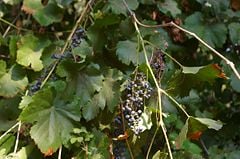 Vitis californica with fruit
| ||||||||||||
| Scientific classification | ||||||||||||
| ||||||||||||
|
Vitis is a genus of about 60 species of vining plants in the flowering plant family Vitaceae. The genus is made up of species predominantly from the Northern hemisphere. It is economically important as the source of grapes, both for direct consumption of the fruit and for fermentation to produce wine. The study and cultivation of grapevines is called viticulture.
Vitaceae are a family of dicotyledonous flowering plants including the grape and Virginia creeper. The family name is derived from the genus Vitis. The name sometimes appears as Vitidaceae, but Vitaceae is a conserved name and therefore has priority over both Vitidaceae and another name sometimes found in the older literature, Ampelidaceae.
Biology
Vitis is distinguished from other genera of Vitaceae by having petals which remain joined at the tip and detach from the base to fall together as a calyptra or 'cap'. The flowers are unisexual or modified to act functionally as unisexual, they are pentamerous with a hypogynous disk. Calyx is greatly reduce or nonexistent in most species and the petals are joined at the summit into one unit but separated at the base. Flower buds are formed later in the growing season and overwinter for blooming in spring of the next year. There are two types of flowers produced, sterile flowers with five long filaments and erect stamens with undeveloped pistils and fertile flowers with well developed pistals and that have five undeveloped reflexed stamens. The fruit is a berry, normally produced with four or less per flower by way of aborted embryos, ovid in shape and juicy.[1]
In the wild, all species of Vitis are normally dioecious, but under domestication, variants with perfect flowers appear to have been selected.
Most Vitis species have 38 chromosomes (n=19), but 40 (n=20) in subgenus Muscadinia. In that respect the Muscadinia are the same as other Vitaceae such as Ampelocissus, Parthenocissus, and Ampelopsis.
Uses
The fruit of several Vitis species are grown commercially for consumption as fresh grapes and for fermentation into wine. Vitis vinifera is much the most important species.
The leaves of the grape vine itself are considered edible and are used in the production of dolmades.
Species
Most Vitis species are found in the temperate regions of the Northern Hemisphere in North America and Asia with a few in the tropics. The wine grape Vitis vinifera originated in southern Europe and southwestern Asia. The species occur in widely different geographical areas and show a great diversity of form. However they are sufficiently closely related to allow easy interbreeding and the resultant interspecific hybrids are invariably fertile and vigorous. Thus the concept of a species is less well defined and more likely represents the identification of different ecotypes of Vitis that have evolved in distinct geographical and environmental circumstances.
The exact number of species is not certain, with species in Asia in particular being poorly defined. Estimates range from 40 to more than 60.[2] Some of the more notable include :
- Vitis vinifera, the European grapevine. Native to the Mediterranean and Central Asia.
- Vitis labrusca, the Fox grapevine, sometimes used for wine. Native to the Eastern United States and Canada.
- Vitis riparia, the Riverbank Grapevine, sometimes used for winemaking and for jam. Native to the entire Eastern U.S. and north to Quebec.
- Vitis rotundifolia (syn. Muscadinia rotundifolia), the Muscadine, used for jams and wine. Native to the Southeastern United States from Delaware to the Gulf of Mexico.
- Vitis vulpina Frost grape. Native to the Midwest east to the coast up through New York.
- Vitis coignetiae Crimson Glory Vine, a species from East Asia grown as an ornamental plant for its crimson autumn foliage.
There are many cultivars of grapevines; most are cultivars of V. vinifera.
Hybrid grapes also exist, and these are primarily crosses between V. vinifera and one or more of V. labrusca, V. riparia or V. aestivalis. Hybrids tend to be less susceptible to frost and disease (notably phylloxera), but wine from some hybrids may have a little of the characteristic "foxy" taste of V. labrusca.
Commercial Distribution
According to the "Food and Agriculture Organization" (FAO), 75,866 square kilometres of the world is dedicated to grapes. Approximately 71% of world grape production is used for wine, 27% as fresh fruit, and 2% as dried fruit. A portion of grape production goes to producing grape juice to be used as a sweetener for fruits canned "with no added sugar" and "100% natural". The area dedicated to vineyards is increasing by about 2% per year.
The following list of top wine-producers shows the corresponding areas dedicated to grapes for wine making:
- Spain 11,750 km²
- France 8,640 km²
- Italy 8,270 km²
- Turkey 8,120 km²
- United States 4,150 km²
- Iran 2,860 km²
- Romania 2,480 km²
- Portugal 2,160 km²
- Argentina 2,080 km²
- Australia 1,642 km²
Sources: FAO, Organisation Internationale de la Vigne et du Vin (pdf), Australian Wine and Brandy Corporation.
Phylloxera is an American root aphid that devastated V. vinifera vineyards in Europe when accitentally introduced in the late 19th century. Attempts were made to breed in resistance from American species, but winemakers didn't like the 'foxy' flavours of the hybrid vines. Fortunately, V. vinifera grafts readily onto rootstocks of the American species, and most commercial production of grapes now relies on such grafts.
The Black vine weevil is another root pest.
Grapevines are used as food plants by the larvae of some Lepidoptera species - see list of Lepidoptera which feed on grapevines.
Description
Grapes grow in clusters of 6 to 300, and can be black, blue, golden, green, purple, red, pink, brown, peach or white. White grapes are evolutionarily derived from the red grape. Mutations in two regulatory genes turn off production of anthocyanin, which is responsible for the color of the red grape.[3].
Grapevines
Most grapes come from cultivars of Vitis vinifera, the European grapevine native to the Mediterranean and Central Asia. Minor amounts of fruit and wine come from American and Asian species such as :
- Vitis labrusca, the North American table and grape juice grapevines, sometimes used for wine. Native to the Eastern United States and Canada.
- Vitis riparia, a wild vine of North America, sometimes used for winemaking and for jam. Native to the entire Eastern U.S. and north to Quebec.
- Vitis rotundifolia, the muscadines, used for jams and wine. Native to the Southeastern United States from Delaware to the Gulf of Mexico.
- Vitis vulpina Frost grape. Native to the Midwest east to the coast up through New York.
- Vitis amurensis Most important Asian species.
The sea grape Coccoloba uvifera is actually a member of the Buckwheat family Polygonaceae and is native to the islands of the Caribbean Sea.
Distribution and production
According to the "Food and Agriculture Organization" (FAO), 75,866 square kilometres of the world are dedicated to grapes. Approximately 71% of world grape production is used for wine, 27% as fresh fruit, and 2% as dried fruit. A portion of grape production goes to producing grape juice to be used as a sweetener for fruits canned "with no added sugar" and "100% natural". The area dedicated to vineyards is increasing by about 2% per year.
The following list of top wine-producers shows the corresponding areas dedicated to grapes for wine making:
- Spain 11,750 km²
- France 8,640 km²
- Italy 8,270 km²
- Turkey 8,120 km²
- United States 4,150 km²
- Iran 2,860 km²
- Romania 2,480 km²
- Portugal 2,160 km²
- Argentina 2,080 km²
- Australia 1,642 km²
Sources: FAO, Organisation Internationale de la Vigne et du Vin (pdf), Australian Wine and Brandy Corporation.
Seedless grapes
Seedlessness is a highly desirable subjective quality in table grape selection, and seedless cultivars now make up the overwhelming majority of table grape plantings. Because grapevines are vegetatively propagated by cuttings, the lack of seeds does not present a problem for reproduction. It is, however, an issue for breeders, who must either use a seeded variety as the female parent or rescue embryos early in development using tissue culture techniques.
There are several sources of the seedlessness trait, and essentially all commercial cultivators get it from one of three sources: Thompson Seedless, Russian Seedless, and Black Monukka. All are cultivars of Vitis vinifera.
Contrary to the improved eating quality of seedlessness is the loss of potential health benefits provided by the enriched phytochemical content of grape seeds[4][5]. (see Health Claims below)
Raisins, currants, and sultanas
A raisin is any dried grape. While raisin is a French loanword, the word in French refers to the fresh fruit; grappe (whence the English grape is derived) refers to the bunch (as in une grappe de raisin).
A currant is a dried Zante grape, the name being a corruption of the French raisin de Corinthe (Corinth grape). Note also that currant has come to refer also to the blackcurrant and redcurrant, two berries completely unrelated to grapes.
A sultana was originally a raisin made from a specific type of grape of Turkish origin, but the word is now applied to raisins made from common grapes and chemically treated to resemble the traditional sultana.
Health claims
Comparing diets among western countries, researchers have discovered that although the French tend to eat higher levels of animal fat, surprisingly the incidence of heart disease remains low in France.[1] This phenomenon has been named the French Paradox. Many scientists now believe the reason is the greater consumption of red wine in France. Something in the grape helps to lower cholesterol levels in the body and thus slows the build up of deposits in the arteries. Doctors do not recommend excessive consumption of red wine, but three or four glasses a week is beneficial and encouraged.
Compounds such as resveratrol (a polyphenol antioxidant) have been discovered in grapes and these have been positively linked to fighting cancer, heart disease, degenerative nerve disease and other ailments. Resveratrol is produced by several plants, apparently for its antifungal properties. Resveratrol has been shown to modulate the metabolism of lipids, and to inhibit the oxidation of low-density lipoproteins and the aggregation of platelets.[6]
Resveratrol is found in widely varying amounts in grapes, primarily the skins and seeds. For instance the skin and seeds of muscadine grapes have about one hundred times the concentration as the pulp.[2] Red or not, grapes of all colors offer comparable benefits. Fresh grape skin contains about 50 to 100 micrograms of resveratrol per gram.[3] The amount found in grape skins also varies with the grape cultivar, its geographic origin, and exposure to fungal infection.
Red wine offers health benefits not found in white wine, because many of the beneficial compounds are found in the skins of the grapes, and only red wine is fermented with the skins. The amount of fermentation time a wine spends in contact with grape skins is an important determinant of its resveratrol content.[4] Ordinary non-muscadine red wine contains between 0.2 and 5.8 mg/L [7], depending on the grape variety, while white wine has much less - the reason being that red wine is fermented with the skins, allowing the wine to absorb the resveratrol, whereas white wine is fermented after the skin has been removed. Wines produced from muscadine grapes, however, both red and white, may contain more than 40 mg/L.[8]. [5]
Since the 1980s, biochemical and medical studies have demonstrated powerful antioxidant properties of grape seed oligomeric proanthocyanidins[9]. Together with tannins, polyphenols and polyunsaturated fatty acids, these seed constituents display inhibitory activities against several experimental disease models, including cancer, heart failure and other disorders of oxidative stress[10][11]. Grape seed oil, from the crushed seeds is used for its perceived wide range of health benefits.
See also
- Grape and raisin toxicity in dogs
External links
- Integrated Taxonomic Information System entry for Grape family
- Area under vine (pdf)
- Wild Grapes
- 300 Grape Varieties for Wine
- Wine Wiki
- SAFECROP - Proceedings of the 5th International Workshop on Grapevine Downy and Powdery Mildew
ReferencesISBN links support NWE through referral fees
- ↑ Gleason and Cronquist volume 2, New Britton and Brown Illustrated Flora of the Northeastern United States and Adjacent Canada. ISBN 63-16478 Page 517
- ↑ Galet, Pierre (2000). Dictionnaire encyclopédique des cépages. Hachette Pratique. ISBN 2012363318.
- ↑ Walker AR, Lee E, Bogs J, McDavid DA, Thomas MR, Robinson SP (2007). White grapes arose through the mutation of two similar and adjacent regulatory genes. Plant J 49 (5): 772–85.
- ↑ Shi J, Yu J, Pohorly JE, Kakuda Y. (2003 Winter). "Polyphenolics in grape seeds-biochemistry and functionality.". J Med Food. 2003 Winter;6(4):291-9.. Retrieved 2007-08-16.
- ↑ Parry J, Su L, Moore J, Cheng Z, Luther M, Rao JN, Wang JY, Yu LL. (2006-05-31). "Chemical compositions, antioxidant capacities, and antiproliferative activities of selected fruit seed flours.". J Agric Food Chem. 2006 May 31;54(11):3773-8.. Retrieved 2007-08-16.
- ↑ Chan, W. K., & Delucchi, A. B. (2000). Resveratrol, a red wine constituent, is a mechanism-based inactivator of cytochrome P450 3A4. Life Sci 67 (25): 3103-3112. Abstract.
- ↑ Gu X, Creasy L, Kester A, et al., Capillary electrophoretic determination of resveratrol in wines. J Agric Food Chem 47:3323-3277, 1999
- ↑ Ector BJ, Magee JB, Hegwood CP, Coign MJ. Resveratrol Concentration in Muscadine Berries, Juice, Pomace, Purees, Seeds, and Wines. http://www.ajevonline.org/cgi/content/abstract/47/1/57
- ↑ Bagchi D, Bagchi M, Stohs SJ, Das DK, Ray SD, Kuszynski CA, Joshi SS, Pruess HG. (2000-08-07). "Free radicals and grape seed proanthocyanidin extract: importance in human health and disease prevention.". Toxicology. 2000 Aug 7;148(2-3):187-97.. Retrieved 2007-08-16.
- ↑ Agarwal C, Singh RP, Agarwal R. (2002-11-23). "Grape seed extract induces apoptotic death of human prostate carcinoma DU145 cells via caspases activation accompanied by dissipation of mitochondrial membrane potential and cytochrome c release.". Carcinogenesis. 2002 Nov;23(11):1869-76.. Retrieved 2007-08-16.
- ↑ Bagchi D, Sen CK, Ray SD, Das DK, Bagchi M, Preuss HG, Vinson JA. (2003-02-01). "Molecular mechanisms of cardioprotection by a novel grape seed proanthocyanidin extract.". Mutat Res. 2003 Feb-Mar;523-524:87-97.. Retrieved 2007-08-16.
Credits
New World Encyclopedia writers and editors rewrote and completed the Wikipedia article in accordance with New World Encyclopedia standards. This article abides by terms of the Creative Commons CC-by-sa 3.0 License (CC-by-sa), which may be used and disseminated with proper attribution. Credit is due under the terms of this license that can reference both the New World Encyclopedia contributors and the selfless volunteer contributors of the Wikimedia Foundation. To cite this article click here for a list of acceptable citing formats.The history of earlier contributions by wikipedians is accessible to researchers here:
The history of this article since it was imported to New World Encyclopedia:
Note: Some restrictions may apply to use of individual images which are separately licensed.
